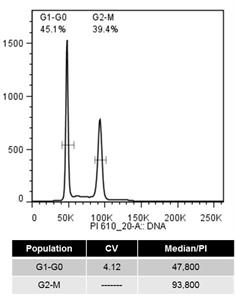
Obtaining good results in DNA analysis depends on proper sample preparation and instrument optimization of the optics and fluidics. The resolution of a flow cytometer can be assessed by measuring the coefficient of variation (CV) of a reference particle: the lower the CV, the better the resolution.
Linearity is critical for DNA experiments. To verify the linearity of DNA data, the pulse-area signal is used to measure the amount of DNA fluorescence detected from cells or nuclei. On an instrument that records data linearly, the doublet peak should be located at twice the mean channel of the singlet peak (see figure at left).
Doublet discrimination, or the ability to resolve singlets from aggregates, is also important for DNA experiments. Aggregated cells or nuclei are detected as events that have two or more times the amount of singlet fluorescence. For cell-cycle analysis, it is important to resolve singlets from aggregates because doublets of G
0/G
1 cells have the same amount of DNA fluorescence as singlet G
2+M cells. Therefore, these doublets accumulate in the same fluorescence area channel as singlet G
2+M cells.